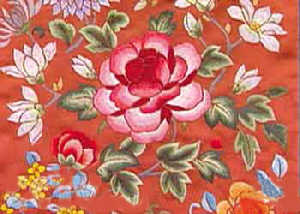
Among the major schools of traditional Chinese embroidery, Jing Xiu handicraft is at the risk of disappearance and has been listed as works of China's own Intangible Cultural Heritage (a list ensuring that China's best culture tradition is preserved and developed as well as made known to the outside world).
Jing Xiu, also called Gongting Xiu or Gong Xiu, was originally made for the imperial household. In Chinese, Xiu means embroidery and Jing was named after Beijing, while Gongting or Gong refers to the royal palace occupied by the imperial families in old China.
The history of Jing Xiu dates back to the Tang Dynasty (618-907) when special workshops were established to produce embroidery items for the imperial household. In the Ming (1368-1644) and Qing (1644-1911) dynasties, the style of Jing Xiu took shape in terms of materials, handcraftsmanship, and embroidery patterns.

Noted for the rigid standard of counted stitch, symbolic patterns, and second-to-none skills, Jing Xiu embroidery took the lead of the Four Minor Embroidery Schools of Qing, along with the embroideries of Lu Xiu from Shandong Province, Bian Xiu from Henan Province, and Ou Xiu from Zhejiang Province.
 Uniqueness
Uniqueness
** Imposing Style
Jing Xiu stands out by its strong influence in the style from the imperial qualities, an attribute that is rare in Chinese embroidery arts. The needlework features elegant colors and grandiose images, marked by rigorous specification on silk material, types of stitches, and design patterns. The whole piece spreads out the smell of dignity, nobility and masculine splendors, as opposed to the local stitch works spiced with delicacy. Although complicated in the design, the booming composition arouses no sense of lavishness but lends itself to aesthetic enjoyment.
